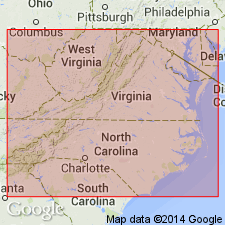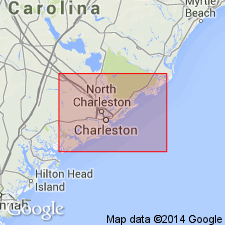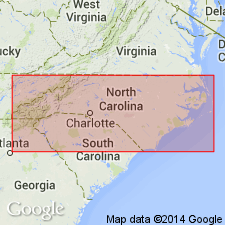
- Usage in publication:
-
- Belgrade Formation*
- Modifications:
-
- Named
- Dominant lithology:
-
- Limestone
- Sand
- AAPG geologic province:
-
- Atlantic Coast basin
Summary:
Unconsolidated, tan to orange, gray to brown oyster-shell beds and phosphatic, calcareous, clayey, shelly quartz sands here named Belgrade Formation. Includes rocks formerly assigned to Trent Marl (now abandoned). Pollocksville and Haywood Landing Members represent penecontemporaneous nearshore and offshore facies. Unconformably overlies River Bend Formation; unconformably underlies Duplin Formation. Thickness ranges from 3 to 31 m; 3 m at type. Age is early Miocene.
Source: GNU records (USGS DDS-6; Reston GNULEX).

- Usage in publication:
-
- Belgrade Formation
- Modifications:
-
- Age modified
- AAPG geologic province:
-
- Atlantic Coast basin
Summary:
On the basis of its correlation with the Old Church Formation, Belgrade Formation and its Haywood Landing and Pollocksville Members are Oligocene and early Miocene.
Source: GNU records (USGS DDS-6; Reston GNULEX).

- Usage in publication:
-
- Belgrade Formation
- Modifications:
-
- Age modified
- Overview
- AAPG geologic province:
-
- Atlantic Coast basin
Summary:
Oligocene and lower Miocene stratigraphic nomenclature in NC was revised almost simultaneously by Baum and others (1978) and Ward and others (1978). According to authors, recent studies indicate that neither interpretation is accurate and further revision is necessary. The interpretation presented here is based on a combination of the earlier revisions. The Belgrade of Baum and others is equivalent to the upper River Bend of Ward and others, whereas the Haywood Landing Member of the Belgrade of Ward and others is equivalent to the Silverdale Formation of Baum and others. Here, the inshore Belgrade and the offshore Silverdale are assigned a late Oligocene age (Chattian) based on calcareous nannofossils of Zones NP24 and NP25. Units correlate with the Ashley Formation of SC. The Haywood Landing Member is not used. The Pollocksville is used informally as Pollocksville beds and is considered early Miocene (Aquitanian).
Source: GNU records (USGS DDS-6; Reston GNULEX).

- Usage in publication:
-
- Belgrade Formation
- Modifications:
-
- Geochronologic dating
- AAPG geologic province:
-
- Atlantic Coast basin
Summary:
The material analyzed in this study consisted of long-ranging, nondiagnostic fossil shells and sandy, glauconitic limestones. Phosphatic materials gave inconsistent results. The age of deposition for each unit was assigned by comparing 87Sr/86Sr results with the seawater strontium curve. Limited data from the Belgrade support a late Oligocene time of deposition, about 3 million years younger than the River Bend.
Source: GNU records (USGS DDS-6; Reston GNULEX).
For more information, please contact Nancy Stamm, Geologic Names Committee Secretary.
Asterisk (*) indicates published by U.S. Geological Survey authors.
"No current usage" (†) implies that a name has been abandoned or has fallen into disuse. Former usage and, if known, replacement name given in parentheses ( ).
Slash (/) indicates name conflicts with nomenclatural guidelines (CSN, 1933; ACSN, 1961, 1970; NACSN, 1983, 2005, 2021). May be explained within brackets ([ ]).

